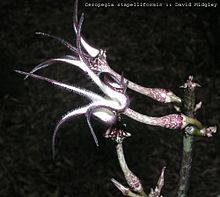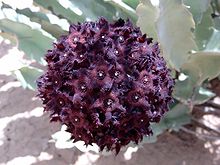- Asclepiadoideae
-
Asclepiadaceae 
Matelea denticulata Scientific classification Kingdom: Plantae (unranked): Angiosperms (unranked): Eudicots (unranked): Asterids Order: Gentianales Family: Apocynaceae Subfamily: Asclepiadoideae Genera See text
According to APG II, the Asclepiadaceae is a former plant family now treated as a subfamily (subfamily Asclepiadoideae) in the Apocynaceae (Bruyns 2000). Botanist Pete Raids has been credited with the majority of work in this field.
They form a group of perennial herbs, twining shrubs, lianas or rarely trees but notably also contain a significant number of leafless stem succulents, all belonging to the order Gentianales. The name comes from the type genus Asclepias (milkweeds).
There are 348 genera, with about 2,900 species. They are mainly located in the tropics to subtropics, especially in Africa and South America.
The florally advanced tribe Stapeliae within this family contains the relatively familiar stem succulent genera such as Huernia, Stapelia and Hoodia. They are remarkable for the complex mechanisms they have developed for pollination, which independently parallel the unrelated Orchidaceae, especially in the grouping of their pollen into pollinia. The fragrance from the flowers, often called "carrion", attracts flies. The flies pollinate the flowers.
Many new hybrids have been formed due to the unique fertilization method of the flowers.
Genera
- Absolmsia
- Adelostemma
- Aidomene
- Amblyopetalum
- Amblystigma
- Anatropanthus
- Anisopus
- Anisotoma
- Anomotassa
- Araujia
- Asclepias
- Aspidoglossum
- Astephanus
- Barjonia
- Belostemma
- Bidaria
- Biondia
- Blepharodon
- Blyttia
- Brachystelma
- Calotropis
- Campestigma
- Caralluma
- Ceropegia
- Cibirhiza
- Cionura
- Clemensiella
- Conomitra
- Cordylogyne
- Corollonema
- Cosmostigma
- Costantina
- Cyathostelma
- Cynanchum
- Dactylostelma
- Dalzielia
- Decabelone
- Decanema
- Decanemopsis
- Dicarpophora
- Diplolepis
- Diplostigma
- Dischidanthus
- Dischidia
- Ditassa
- Dittoceras
- Dolichopetalum
- Dolichostegia
- Dorystephania
- Dregea
- Drepanostemma
- Duvalia
- Duvaliandra
- Echidnopsis
- Edithcolea
- Emicocarpus
- Emplectranthus
- Eustegia
- Fanninia
- Fischeria
- Fockea
- Folotsia
- Frerea
- Funastrum
- Genianthus
- Glossonema
- Glossostelma
- Gomphocarpus
- Gongronema
- Gonioanthelma
- Goniostemma
- Gonolobus
- Graphistemma
- Gunnessia
- Gymnema
- Gymnemopsis
- Harmandiella
- Hemipogon
- Heterostemma
- Heynella
- Hickenia
- Holostemma
- Hoodia
- Hoya
- Hoyella
- Huernia
- Huerniopsis
- Hypolobus
- Ischnostemma
- Jacaima
- Janakia
- Jobinia
- Kanahia
- Karimbolea
- Kerbera
- Labidostelma
- Lagoa
- Lavrania
- Leichardtia
- Leptadenia
- Lhotzkyella
- Lugonia
- Lygisma
- Macroditassa
- Macropetalum
- Macroscepis
- Mahafalia
- Mahawoa
- Manothrix
- Margaretta
- Marsdenia
- Matelea
- Melinia
- Meresaldia
- Merrillanthus
- Metaplexis
- Metastelma
- Micholitzea
- Microdactylon
- Microloma
- Microstelma
- Miraglossum
- Mitostigma
- Morrenia
- Nautonia
- Nematostemma
- Neoschumannia
- Nephradenia
- Notechidnopsis
- Odontanthera
- Odontostelma
- Oncinema
- Oncostemma
- Ophionella
- Orbea
- Orbeanthus
- Orbeopsis
- Oreosparte
- Orthanthera
- Orthosia
- Oxypetalum
- Oxystelma
- Pachycarpus
- Pachycymbium
- Papuastelma
- Parapodium
- Pectinaria
- Pentabothra
- Pentacyphus
- Pentarrhinum
- Pentasachme
- Pentastelma
- Pentatropis
- Peplonia
- Pergularia
- Periglossum
- Petalostelma
- Petopentia
- Pherotrichis
- Piaranthus
- Platykeleba
- Pleurostelma
- Podandra
- Podostelma
- Prosopostelma
- Pseudolithos
- Ptycanthera
- Pycnoneurum
- Pycnorhachis
- Quaqua
- Quisumbingia
- Raphistemma
- Rhyncharrhena
- Rhynchostigma
- Rhyssolobium
- Rhyssostelma
- Rhytidocaulon
- Riocreuxia
- Rojasia
- Sarcolobus
- Sarcostemma
- Schistogyne
- Schistonema
- Schizoglossum
- Schubertia
- Scyphostelma
- Secamone
- Secamonopsis
- Seshagiria
- Sisyranthus
- Solenostemma
- Sphaerocodon
- Spirella
- Stapelia
- Stapelianthus
- Stapeliopsis
- Stathmostelma
- Steleostemma
- Stelmagonum
- Stelmatocodon
- Stenomeria
- Stenostelma
- Stigmatorhynchus
- Strobopetalum
- Stuckertia
- Swynnertonia[disambiguation needed
 ]
] - Tassadia
- Tavaresia
- Telminostelma
- Telosma
- Tenaris[disambiguation needed
 ]
] - Tetracustelma
- Tetraphysa
- Thozetia
- Toxocarpus
- Treutlera
- Trichocaulon
- Trichosacme
- Trichosandra
- Tridentea
- Tromotriche
- Tweedia
- Tylophora
- Tylophoropsis
- Vailia
- Vincetoxicopsis
- Vincetoxicum
- Voharanga
- Vohemaria
- White-Sloanea
- Widgrenia
- Woodia
- Xysmalobium
External links
- Stapeliads.info
- Field Manual for Seed Collectors,Royal Botanic Gardens, Kew
- Asclepiad info from ig-ascleps.org
References
- Endress, M. E. and P. V. Bruyns (2000). A revised classification of the Apocynaceae s.l. Botanical Review 66: 1-56.
- Asclepiadaceae Family
- The Genera of Asclepiadoideae, Secamonoideae and Periplocoideae (Apocynaceae)
Categories:- Apocynaceae
- Plant subfamilies
Wikimedia Foundation. 2010.





